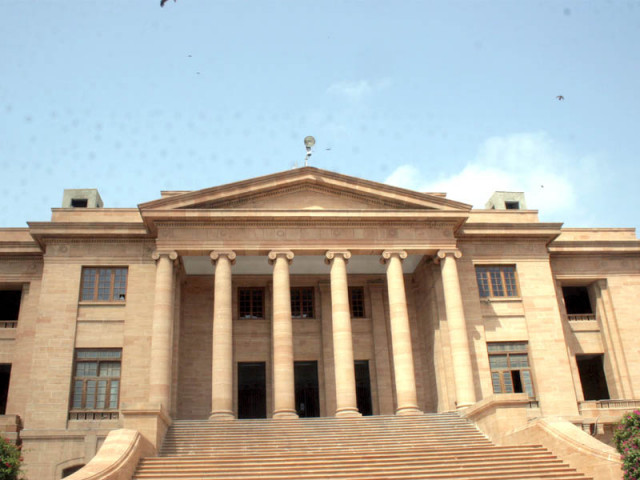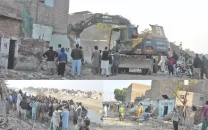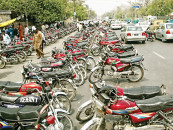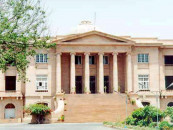SHC seeks data on government schools
Petitioners request court to form JIT to look into condition of schools in the province

The petitioners informed the Sindh High Court that there were not enough middle and high schools in the province to provide necessary education to children. PHOTO: EXPRESS
A two-judge bench, headed by Justice Aqeel Ahmed Abbasi, also directed the secretary to submit details regarding allocation and utilisation of funds for the government schools in the last five years. The secretary was told to submit such details by January 31.
The judges were hearing a petition jointly filed by two civil rights campaigners, Muhammad Alamgir Khan of FixIt and Atam Parkash of Justice Helpline Trust, who took to court the provincial chief secretary, secretaries of the education and finance departments and member of the education sector planning and development board over poor standards of education in the province.
The petitioners informed the court that there were not enough middle and high schools in the province to provide necessary education to children. Citing a survey report, the petitioners argued that around 6,000 government schools were not functioning in the province, while there were more than 40,000 ghost teachers and non-teaching staff across the province.
Former AIG approaches SHC for denial of promotion
The petitioners' lawyer, Nadeem Shaikh, argued that political influence was a main factor behind the decline in education standard in Sindh. He alleged that this was evident with past experience when the provincial government asked the government teachers for biometric verification to confirm their employment but the whole procedure was sabotaged by corrupt teachers and politicians.
Shaikh recalled the provincial assembly had passed the Sindh Right of Children to Free and Compulsory Education Bill in February, 2013 to provide free-of-cost education to every child in the province. "Clause 3(1) of the said Act clearly mentions that every child of the age of five to 16 years regardless of sex and race shall have a fundamental right to free and compulsory education in a school," he argued, referring to the law.
The judges were informed that according to a survey conducted by the Sindh education department, 77% of schools were in unsatisfactory condition and almost 50% did not have basic facility of clean drinking water.
The petitioners maintained that the Sindh government claimed to promote education in the province under its 'education emergency' plan but no improvement had been observed in the education sector and the conditions had, in fact, become worse.
There were two parallel systems of education in the country, the petitioners maintained. One of the systems was related to public sector and the other one was the outcome of private investors, they claimed.
SHC seeks record of SIUT's Sukkur hospital
The petitioners requested the court to order the constitution of a joint investigation team consisting of members from all investigation authorities, including the Pakistan Army, and direct them to investigate the matter impartially and honestly.
Report of an NGO
Education in the province has been a hotly debated issue this year. With Chief Minister Murad Ali Shah declaring an 'education emergency' across Sindh, reports have poured in of schools without basic infrastructure or facilities.
Referred by the petitioners, the recently published report of Alif Ailaan, a non-profit organisation working for educational reforms, has revealed the poor state of facilities and standards of learning in Sindh.
As many as 155 districts of Punjab, Sindh, Khyber-Pakhtunkhwa, Balochistan, Islamabad, Gilgit-Baltistan, Federally Administered Tribal Areas and Azad Jammu and Kashmir have been ranked in the report on the basis of facilities at schools and educational standards. The report's infrastructure parameters include electricity, water, toilets, boundary walls and building conditions, while the education scores comprise learning, retention and gender parity.
Regrettably, not a single district of Sindh was placed among the top 60 on the count of primary schools' infrastructure. With a 77.5 score, Karachi's District East is ranked at 61st place and happens to be on the top in Sindh. But even in that district are around three dozen schools without walls. In the category of middle schools, District South is ranked at 57.
Defrauding NICL: SHC allows NAB probe against JS Investments
In Sindh's second largest city, Hyderabad, around 150 primary and middle schools are without boundary walls, based on comparison of Alif Ailaan's district ranking and data of the Sindh Education Management Information System. The district is ranked at 68 in the primary segment and 62 in the middle school category.
Sujawal, which finds itself among the lowest ranks at 143 and 148 in the primary and middle school categories respectively, has an estimated 1,000 schools which do not have surrounding walls. Likewise, among more than 4,000 government schools in Tharparkar, 57% primary and 30% middle schools are without walls.
Similarly, 57% primary and 26% middle schools in Thatta district and 60% primary and 31% middle schools in Kashmore district also lack boundary walls. Up to 54% primary and 32% middle schools in Mirpurkhas and Jacobabad, 52% and 36% in Badin, 44% and 40% in Umerkot and 40% and 20% in Tando Muhammad Khan also do not have walls.
The situation in Dadu, Ghotki, Sanghar, Benazirabad, Khairpur and other districts vis-a-vis the walls does not appear better.
The boundary walls, besides being one of the security prerequisites, also help improve attendance and enrolment. Parents particularly are not willing to send their daughters to such schools because of safety concerns.



















COMMENTS
Comments are moderated and generally will be posted if they are on-topic and not abusive.
For more information, please see our Comments FAQ